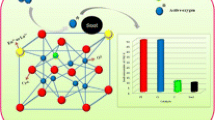Abstract
Ceria materials were modified by doping with gadolinia or yttria and by a hold period at 260 °C for 2 h during temperature-programmed calcinations to 650 °C. These doped ceria-supported copper oxide catalysts and the doped ceria material were characterized by temperature-programmed reduction, electron paramagnetic resonance, and CO oxidation activity test. It was observed that, as the doping concentration of gadolinia increases, the reduction temperature of the copper oxide species increases and the CO oxidation activity decreases. This is due to increased formation of the surface spinel species of copper oxide with gadolinia. As the yttria content increases to greater than 10 mol%, surface segregation occurs, which causes the amount of surface oxygen vacancies to decrease. It was also found that maintaining the temperature at 260 °C during calcination may decrease the amount of oxygen vacancies. The surface oxygen vacancies may be the active sites for CO oxidation over the oxygen ion conducting materials in the absence of any metal present. Gd doping leads to the formation of extrinsic oxygen vacancies, which increases the oxygen ionic conductivity of the doped ceria and thus increases the CO oxidation activities of the supported catalysts as well as of the doped ceria.
Similar content being viewed by others
References
S. J. Tauster, S. C. Fung and R. L. Garten, J. Am. Chem. Soc. 100 (1978) 170.
S. J. Tauster and S. C. Fung, J. Catal. 55 (1978) 29.
R. Burch and A. R. Flambard, J. Catal. 78 (1982) 389.
W. P. Dow and T. J. Huang, J. Catal. 147 (1994) 322.
D. H. Tsai and T. J. Huang, Appl. Catal. A223 (2002) 1.
J. B. Wang, H. K. Lee and T. J. Huang, Catal. Lett. (in press).
M. G. Sanchez and J. L. Gazquez, J. Catal. 104 (1987) 120.
W. P. Dow, Y. P. Wang and T. J. Huang, J. Catal. 160 (1996) 155.
W. P. Dow and T. J. Huang, J. Catal. 160 (1996) 171.
J. B. Wang, D. H. Tsai and T. J. Huang, J. Catal. 208 (2002) 370.
P. L. Chen and I. W. Chen, J. Am. Ceram. Soc. 77 (1994) 2289.
B. H. Chen, D. Walker, E. Y. Suard and B. A. Scott, Chem. Mater. 7 (1995) 355.
H. C. Yao and Y. F. Yu, J. Catal. 86 (1984) 254.
J. B. Wang, Y. L. Tai, W. P. Dow and T. J. Huang, Appl. Catal. A218 (2001) 69.
W. P. Dow, Ph.D. Thesis, National Tsing Hua University, Taiwan, 1995.
M. Mogensen, T. Lindegard and U. R. Hansen, J. Electrochem. Soc. 141 (1994) 2122.
L. K. Tseng and T. J. Huang, J. Chin. Inst. Chem. Engrs. 31 (2000) 493.
Author information
Authors and Affiliations
Corresponding author
Rights and permissions
About this article
Cite this article
Huang, TJ., Kung, YC. Effect of Support Modification on Reduction and CO Oxidation Activity of Doped Ceria-Supported Copper Oxide Catalyst. Catalysis Letters 85, 49–55 (2003). https://doi.org/10.1023/A:1022164606934
Issue Date:
DOI: https://doi.org/10.1023/A:1022164606934




